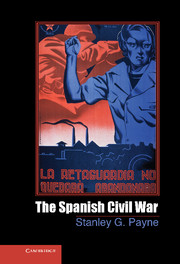Book contents
- Frontmatter
- Contents
- Chronology of Major Events
- Glossary
- Preface
- Introduction Civil War in Twentieth-Century Europe
- 1 Modernization and Conflict in Spain
- 2 From Revolutionary Insurrection to Popular Front
- 3 The Breakdown of Democracy
- 4 The Military Insurrection of the Eighteenth of July
- 5 The Battle of Madrid – the First Turning Point
- 6 Revolution
- 7 Terror
- 8 A War of Religion
- 9 Franco's Counterrevolution
- 10 Foreign Intervention and Nonintervention
- 11 Soviet Policy in Spain, 1936–1939
- 12 The Propaganda and Culture War
- 13 A Second Counterrevolution? The Power Struggle in the Republican Zone
- 14 The Decisive Northern Campaigns of 1937–1938
- 15 The War at Sea and in the Air
- 16 Civil Wars within a Civil War
- 17 The War in Perspective
- Conclusion Costs and Consequences
- Select Bibliography
- Index
- References
13 - A Second Counterrevolution? The Power Struggle in the Republican Zone
Published online by Cambridge University Press: 05 September 2012
- Frontmatter
- Contents
- Chronology of Major Events
- Glossary
- Preface
- Introduction Civil War in Twentieth-Century Europe
- 1 Modernization and Conflict in Spain
- 2 From Revolutionary Insurrection to Popular Front
- 3 The Breakdown of Democracy
- 4 The Military Insurrection of the Eighteenth of July
- 5 The Battle of Madrid – the First Turning Point
- 6 Revolution
- 7 Terror
- 8 A War of Religion
- 9 Franco's Counterrevolution
- 10 Foreign Intervention and Nonintervention
- 11 Soviet Policy in Spain, 1936–1939
- 12 The Propaganda and Culture War
- 13 A Second Counterrevolution? The Power Struggle in the Republican Zone
- 14 The Decisive Northern Campaigns of 1937–1938
- 15 The War at Sea and in the Air
- 16 Civil Wars within a Civil War
- 17 The War in Perspective
- Conclusion Costs and Consequences
- Select Bibliography
- Index
- References
Summary
Hugh Thomas titled the last part of his classic history of the Civil War “The War of the Two Counter Revolutions.” Certainly the extreme revolutionary left – the FAI-CNT, POUM, and many of the caballerista Socialists – accused the Communists and their allies (left Republicans and the more moderate sectors of Socialists) of imposing counterrevolution. Was this correct? The charge always infuriated the Communists, because they claimed to be the only serious revolutionaries in Spain, the only ones who had experience carrying out a successful revolution. They insisted that they simply sought to apply necessary revolutionary discipline, indispensable to the revolution's long-term success. What both the extreme left and some historians called a left-wing counterrevolution was a calculated strategy to restore order among the left and prosecute the war more effectively. This also enabled the Communists to achieve a limited, but very incomplete, hegemony.
For the leaders of the Communist International in Moscow, the situation had become paradoxical. For fifteen years they had tried to provoke or exploit revolutionary situations worldwide. The Comintern had attempted multiple violent initiatives in Germany, insurrections in Bulgaria, Estonia, and Brazil, a revolutionary takeover in southeast Asia, and even an effort to blow up the entire Bulgarian government. Nonetheless, what was called revolutionary Third Period policy had backfired disastrously, requiring the switch to the Popular Front strategy. This partial moderation of Communist tactics then coincided with the acceleration of the revolutionary process in Spain. By the time the civil war began, the bulk of the Spanish worker left was positioned tactically to the left of the PCE.
- Type
- Chapter
- Information
- The Spanish Civil War , pp. 169 - 182Publisher: Cambridge University PressPrint publication year: 2012



